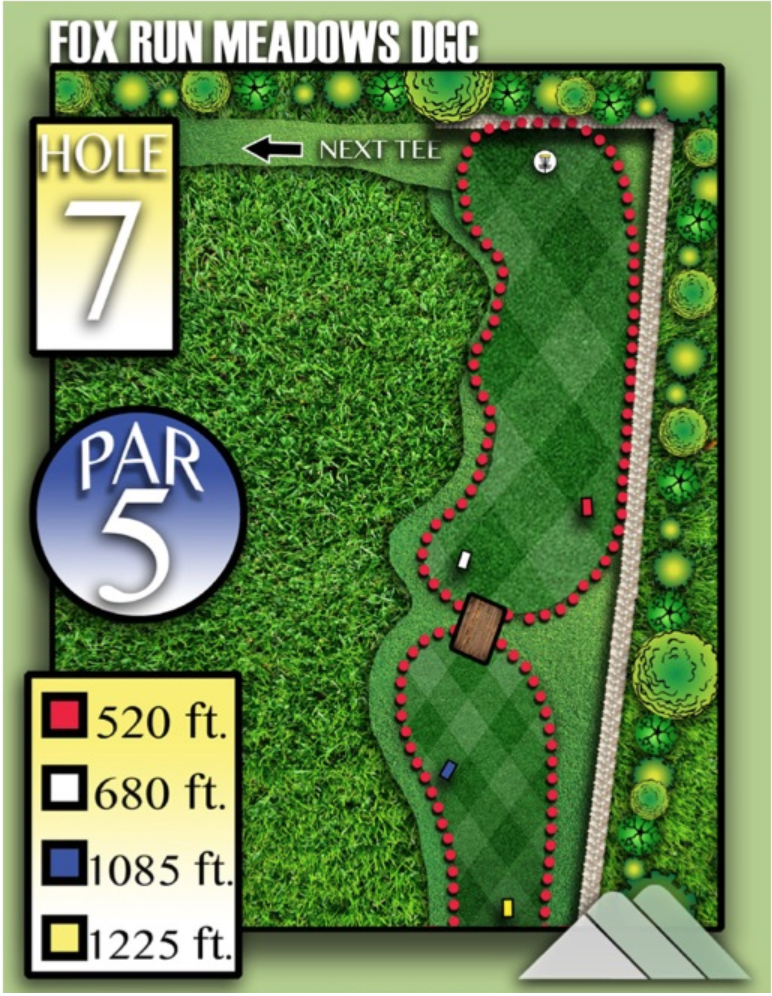In the clip below, you'll see one of the most dramatic instances of out-of-bounds (OB) from the entire 2018 season. For context, this is a moment from the final round of the Disc Golf Pro Tour (DGPT) Championship at New World Disc Golf in Jacksonville, Florida filmed by Smashboxx for the DGPT.
When the card made it to the island green and saw the disc lying in that gap in the railroad ties, a dramatic scene commenced. This included Sexton taking two shots (a made provisional putt from outside the circle that would've been a birdie and carding a bogey from the drop zone), a speakerphone conversation with tournament director (TD) Steve Dodge, and a final post-round debate. Dodge’s ruling was that the OB line was exactly as wide as the railroad ties—“a big fat line,” as Sexton put it, not a thinner line on the inside or outside edge of the ties.
At the end of the round, that one OB stroke was the only thing separating Sexton and Dickerson's scores. What's more, had holes 16-18 played out with no changes after Sexton put in his provisional birdie-that-wasn't-to-be, the missing railroad tie cost him $4500.
After this event, debate about the nature of OB at pro tournaments commenced on social media, and I can’t imagine that hole 15 at New World isn’t on the mind of many tournament directors as they plan their events and ready their courses for 2019.
This significant incident at the last major event of the season gave OB a prominent place in my mind, as well. It got me thinking about how OB can define courses and tournaments, how it often decides championships, and the huge differences it can make to players’ wallets. My curiosity piqued, I used UDisc Live data from 2018 to help answer three of my biggest questions:
1. What courses and holes scored on UDisc Live in the 2018 season had the highest OB rates?
2. Was there any player or playing style that consistently won the battle to have the lowest OB rate?
3. Regarding the holes, were there any features that seemed to guarantee high OB rates?
The Courses and the Idea of “Safe” Play
UDisc Live defines an individual’s OB rate as “the total number of OB strokes divided by the total number of holes tracked.” To broaden that analysis for the 37 courses played at the 22 tournaments scored on UDisc Live, we calculated every hole’s OB rate by dividing the total number of OB strokes by the total number of tracked players across the rounds. Then we generated a sum of those average hole OB rates for each course:
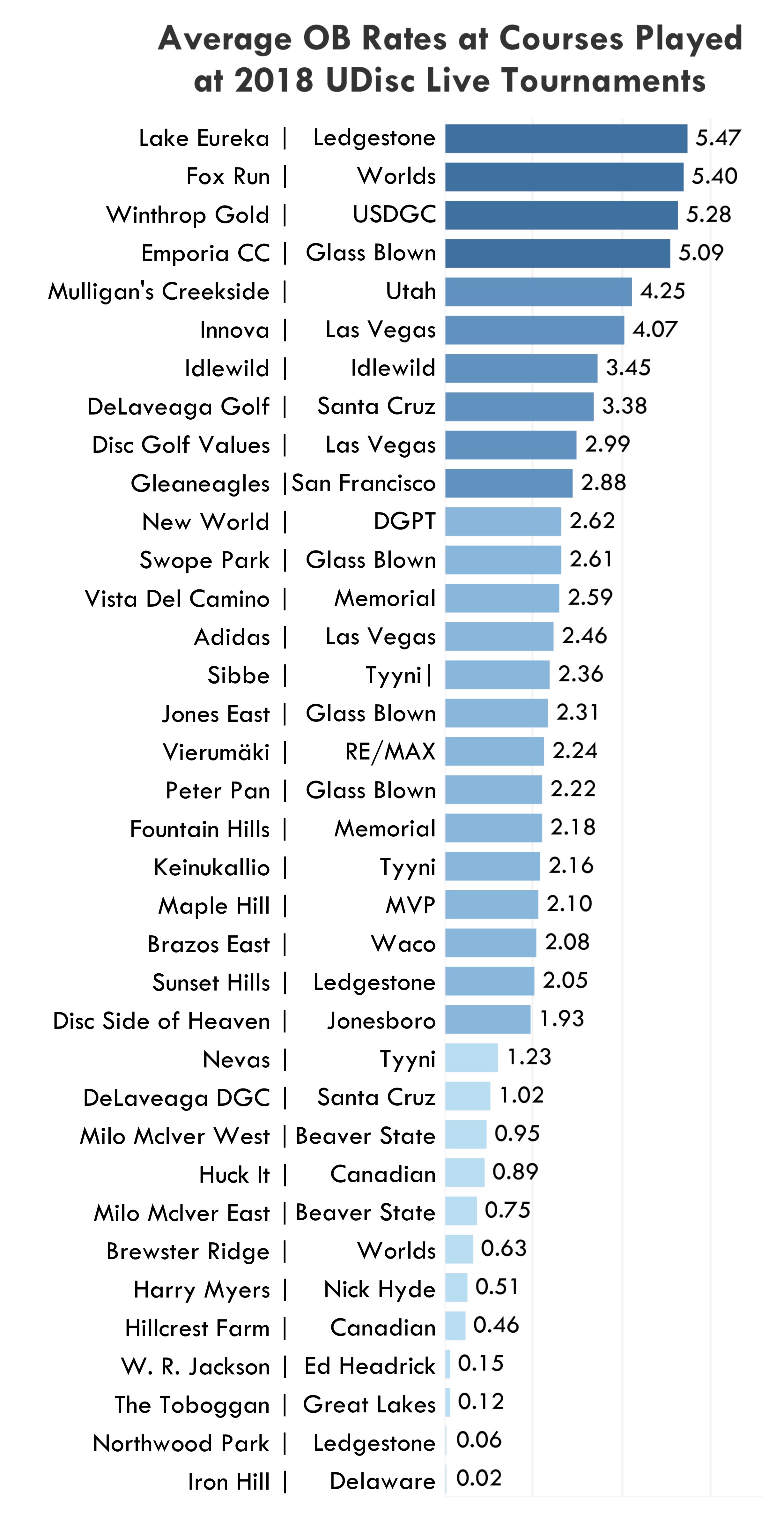
The numbers in the graphic include alternate tees, either for alternating tees on different days at places like Winthrop or Lake Eureka, with playoffs or finals, or with Open/Open Women differences. I know there are issues with that choice (and I’m sure I will hear about them!), but take a look at the hole with the third highest OB rate in my data set, Fox Run’s hole 7:
The yellow Open pad is 200 feet farther than the blue Open Women's tee, but the tight OB lines to the sides and long are what make this hole a beast, and the assumption that teepad distances are so important that they count as different holes for the purposes of analysis seems to presume a lot about how distance defines the experience of a hole over and above other elements.
Keeping these caveats in mind, I had a very good idea of what courses were the most treacherous for players last year. My next quandary was if I could identify a player or type of player who seemed best at avoiding OB. To my surprise, the data showed me nothing of the sort.
Just taking the four OB-heaviest courses with the darker blue bars, those tournaments were won by Nate Sexton, Gregg Barsby, Paul McBeth, and Eagle McMahon for the Open, and Jessica Weese, Paige Bjerkaas, and Paige Pierce for Open Women (the US Women’s Championship did not have rounds at Winthrop). Given the variety of playing styles represented by these players (for example, Sexton being considered more calculating and Barsby and McBeth being thought of as more willing to take risks), there didn’t seem to me to be a defining characteristic that made players likelier to avoid OB.
The Holes: What Kind of OB Design Is the Toughest?
To draw the focus a bit tighter, let’s take a look at the 20 holes with the highest OB Rate (the total number of OB strokes divided by the number of tracked players):
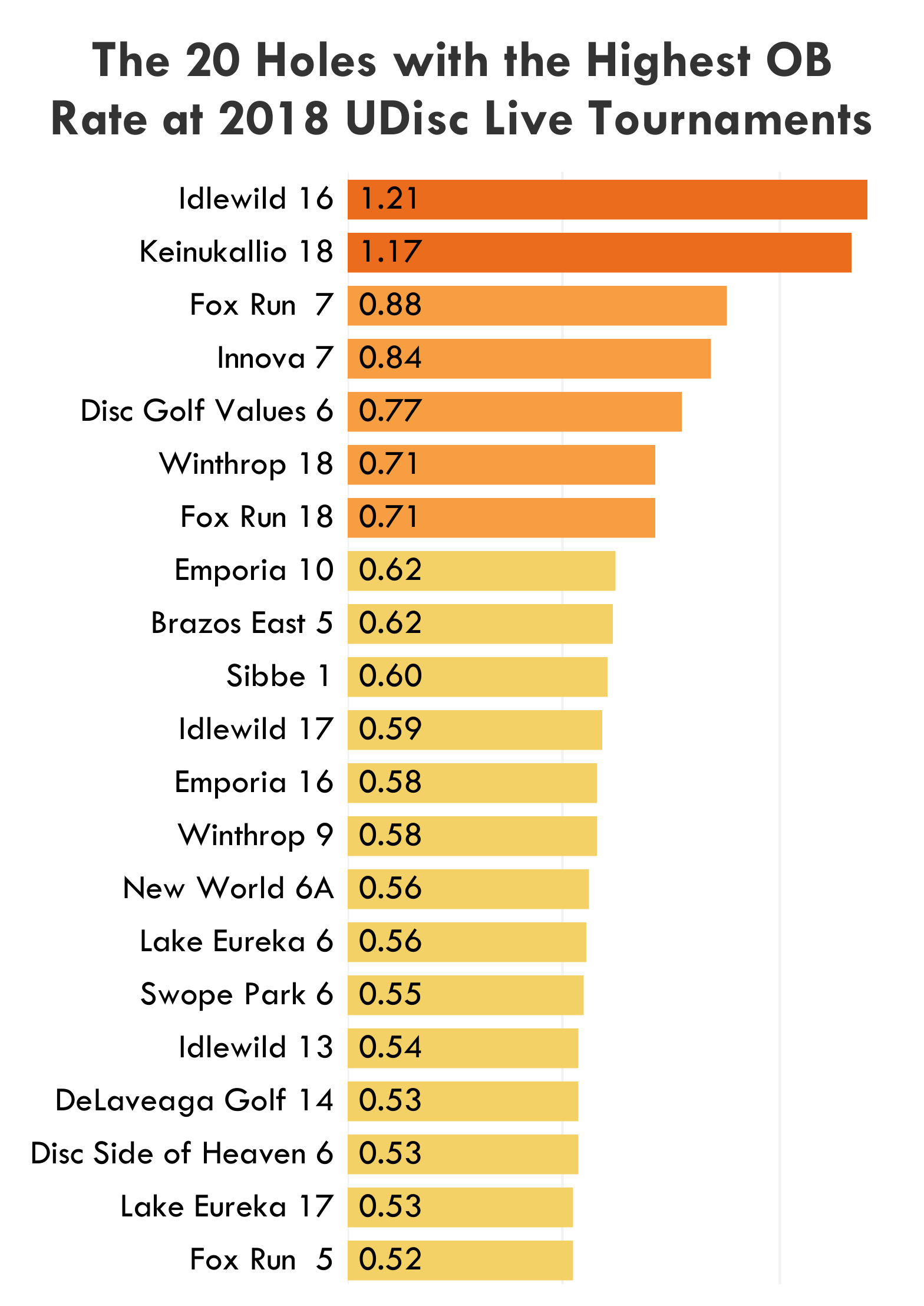
Many of the holes on this list have a lot in common. For example, take a look at the similarities between the top two holes, Idlewild 16 and Keinukallio 18 (a hole from the Tyyni tournament in Finland):
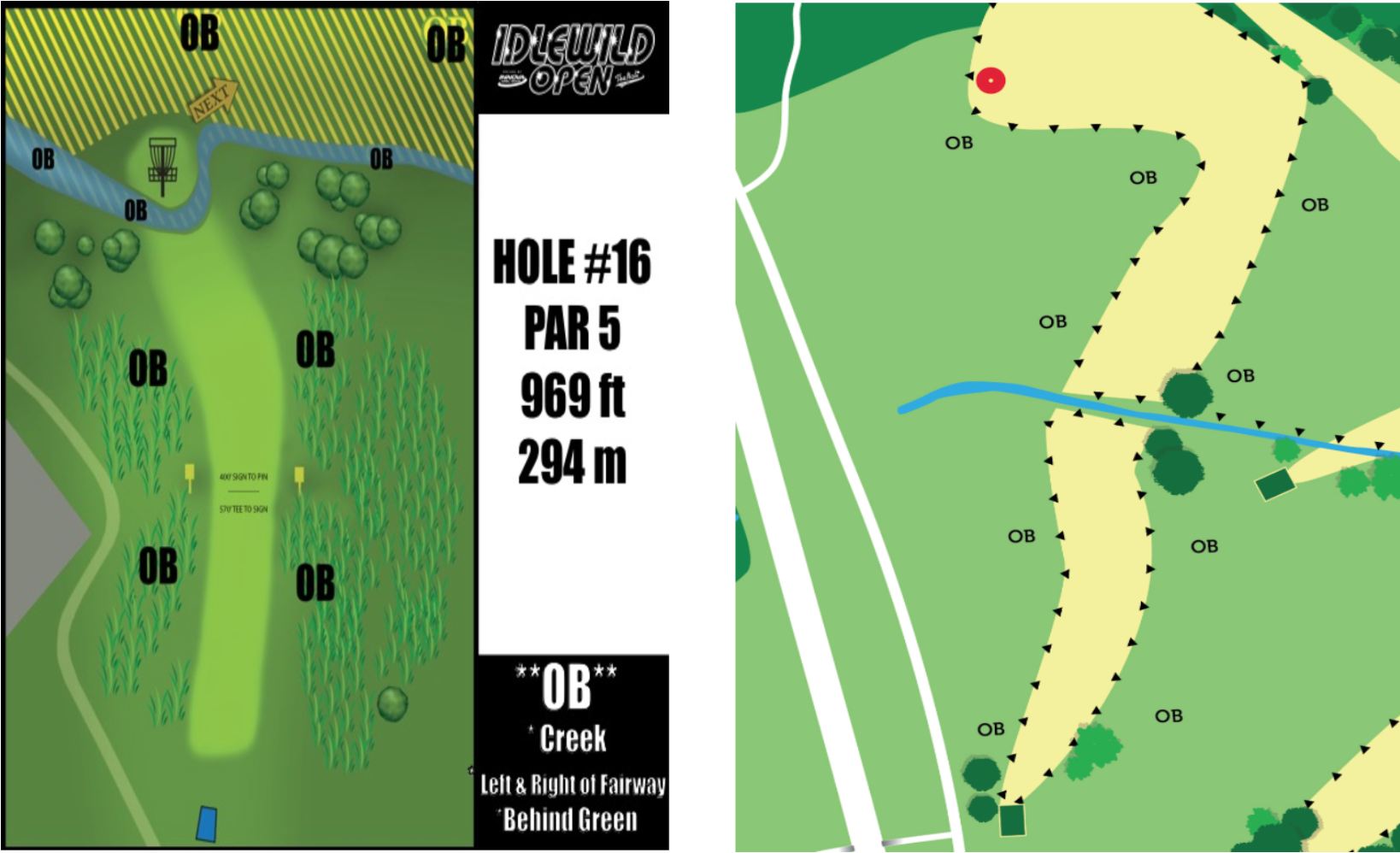
Though the Keinukallio 18 graphic doesn't include distance, it is, like Idlewild 16, an enormous 800+ foot (240+ meter) crush. Also like Idlewild 16, it's downhill and has fairways with tight OB right and left, as well as OB long. These kinds of holes where players have to find the perfect balance between power and accuracy make up the bulk of the list. However, as is the case with Idlewild 16, seemingly small features like an island green covered in artificial turf can also really help rack up the OB strokes. Just take a look at what the crew at JomezPro caught on film during the first round of the 2018 Idlewild Open:
Specific details of other holes on our list probably also stick out in the memory of disc golf fans dedicated to watching the coverage of each big event. There are the controversial triple island holes of Disc Golf Values 6 and 2018's version of Winthrop 9 and the unique and immediately memorable Idlewild 17, with the OB creek snaking down the fairway. Still, water and islands aren't what truly define this list; instead, it's fairways being tightened and shortened by lines decided upon by tournament staff. See what I mean in this checklist of features1:
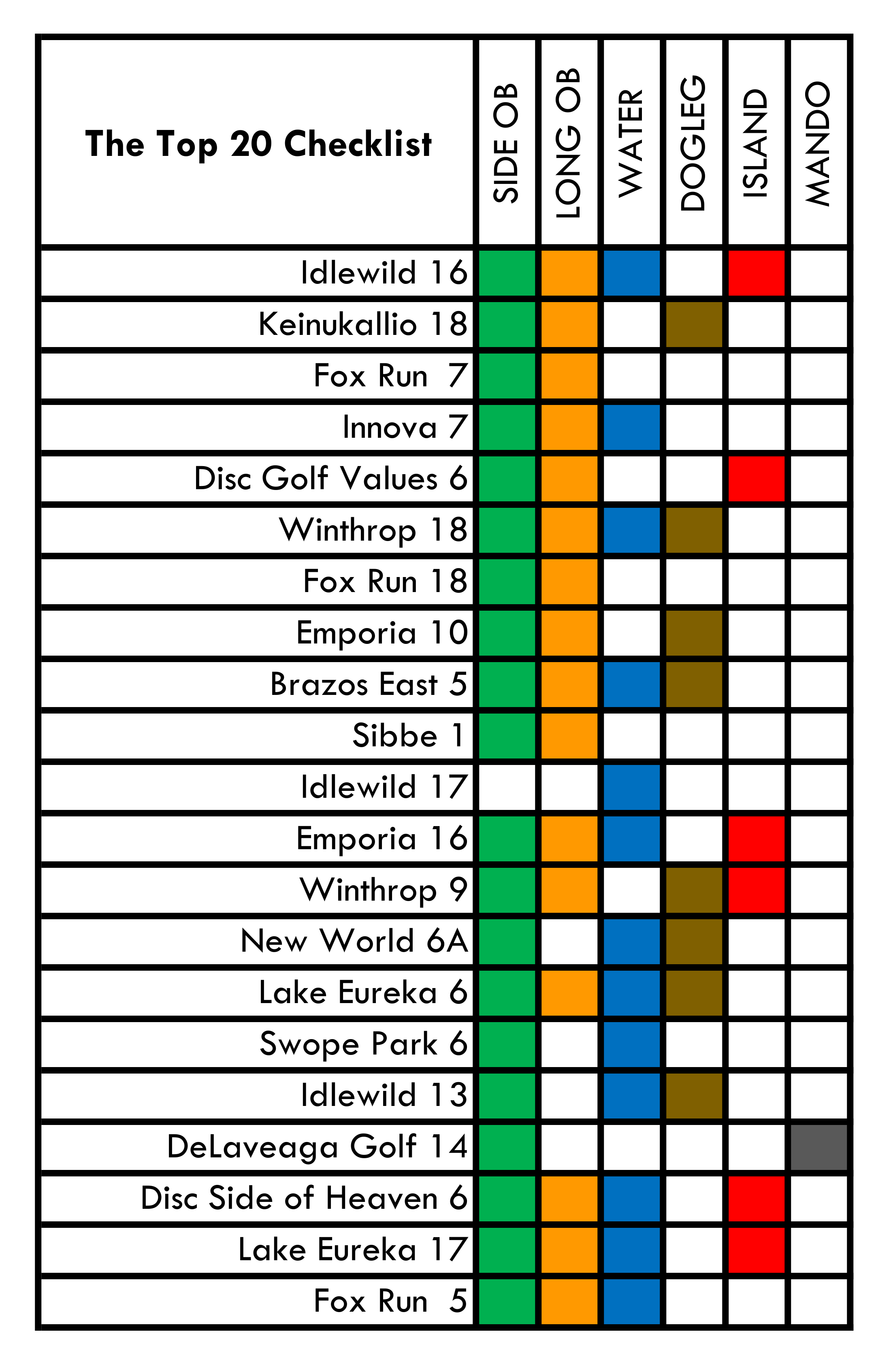 Conclusion
Conclusion
Each season there are some OB moments—like that of Nate Sexton in Florida this year—that really seem to define tournaments, but if we look closer, the impact of OB is monumental in the deep structure of the pro game. In fact, in Open, the winner of Worlds, the USDGC, the NT Finale, and the DGPT Championship had (or tied for) the lowest personal OB rate of the top ten finishers. In Open Women that was the case for the NT Finale and DGPT.
For yet another thing to gnaw on about OB's influence on the biggest events in disc golf, consider that the Emporia Country Club that hosted all Open rounds of last year's Glass Blown Open had 16 holes over the OB average for the set of courses I examined.
Does being able to navigate intricate OB setups make someone the best disc golfer? To me, much of the 2018 professional circuit would suggest that we (or at least those choosing which events are granted elite status) have chosen to think so.
And, admittedly, without such configurations, we wouldn’t have drama like when Simon Lizotte approached Hole 17 of the DGPT Semifinals. Looking to catch Kevin Jones for the wildcard spot, Lizotte had to decide whether or not to take the “hero shot” over the OB to hit the dogleg fairway 500 feet away (video filmed by Smashboxx for the DGPT):
Ultimately, what I took away from my research into this topic is that it seems our sport is at something of a turning point as it grows. What kinds of courses should define greatness? What kinds of decisions do we want to see elite golfers making in the last few holes of major tournaments? If the beauty of the game is in the balance of power and precision, how do we best test that fulcrum, and is a lot of artificial OB the answer?
1. I had to make a judgment call at what angle to classify something a "dogleg," and I settled on circa 150°.
Note: Credit to Alyssa Van Lanen for the featured image of the spotter for this piece seen in search engines and our blog page.

